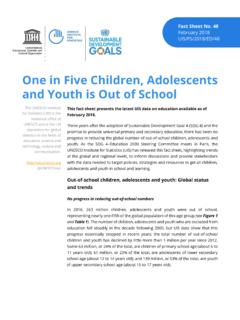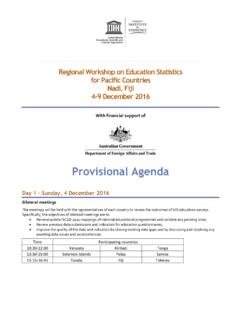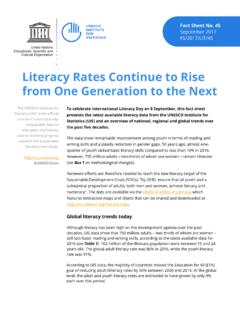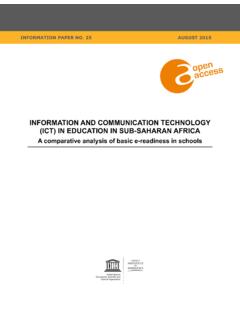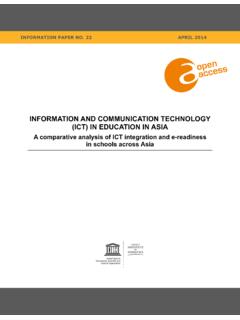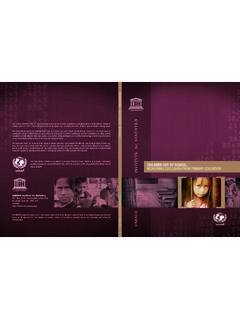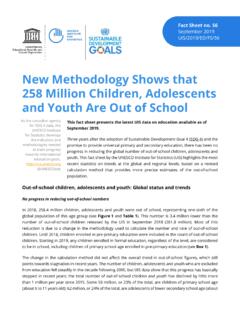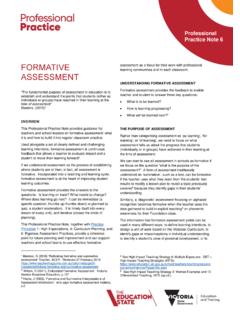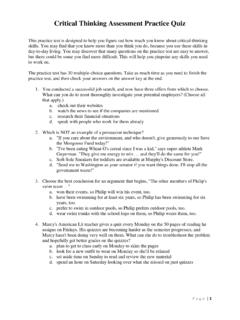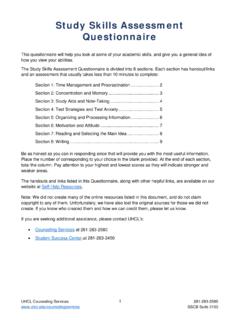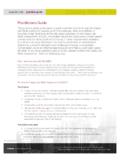Transcription of Principles of Good Practice in Learning Assessment
1 Principles of good Practice in Learning Assessment The ACER Centre for Global Education Monitoring Table of contents List of abbreviations .. i List of figures .. i List of tables .. i Acknowledgements .. i Introduction .. 2. Organisation of the GP-LA .. 4. Broader quality context for the GP-LA: The UN Fundamental Principles of Official Statistics .. 4. Key quality concepts for Learning assessments .. 5. Fitness for purpose .. 6. Clarity and consistency of purpose .. 6. Objectivity and independence .. 6. Transparency and accountability .. 7. Technical rigour .. 7. Ethicality and fairness .. 7. good Practice in Learning Assessment .. 9. Key Area 1: Formulating policy goals and priorities to be addressed with the Learning 9.
2 Key Area 2: Establishing and managing an Assessment team responsible for designing and implementing the Learning Assessment .. 11. Key Area 3: Formulating and articulating technical standards to guide Assessment 14. Key Area 4: Developing an Assessment framework .. 16. Key Area 5: Developing high quality cognitive instruments .. 18. Key Area 6: Developing high quality contextual instruments .. 20. Key Area 7: Linguistic quality control for translation of cognitive and contextual instruments .. 22. Key Area 8: Designing the cognitive and contextual instruments .. 25. Key Area 9: Sampling .. 27. Key Area 10: Standardised field 31. Key Area 11: Managing data .. 34. Key Area 12: Scaling cognitive and contextual data.
3 37. Key Area 13: Analysing data .. 41. The Manual of good Practice in Learning Assessment i Key Area 14: Reporting and dissemination .. 43. Appendix .. 49. Mapping GP-LA to UN Fundamental 49. Glossary .. 52. Bibliography .. 60. The ACER Centre for Global Education Monitoring List of abbreviations ACER Australian Council for Educational Research ACER-GEM ACER Centre for Global Education Monitoring CTT Classical Test Theory GAML Global Alliance to Monitor Learning GPE Global Partnership for Education GP-LA Principles of good Practice in Learning Assessment IEA International Association for the Evaluation of Educational Achievement IRT Item Response Theory NCERT National Council of Educational Research and Training OECD Organisation for Economic Co-operation and Development PISA Programme for International Student Assessment SDG Sustainable Development Goal TIMSS Trends in International Mathematics
4 And Science Study UIS UNESCO Institute for Statistics UN United Nations UNESCO United Nations Educational, Scientific and Cultural Organisation List of figures Figure 1: The 14 key areas of a robust Assessment program 9. Figure 2: Example Assessment team organization 13. List of tables Table 1: UN Fundamental Principles of Official Statistics 5. Table 2: Dissemination methods 46. Table 3: Relationship between the UN Fundamental Principles of Official Statistics and good Practice in Learning Assessment 49. The Manual of good Practice in Learning Assessment i The ACER Centre for Global Education Monitoring Acknowledgements The Principles of good Practice in Learning Assessment ' document was authored by the Australian Council for Educational Research (ACER), Centre for Global Education Monitoring (ACER-GEM), in collaboration with the UNESCO Institute for Statistics (UIS), Global Alliance to Monitor Learning (GAML).
5 Valuable input was provided by the GAML secretariat at UIS (lead by Silvia Montoya), and the GAML Assessment Implementation Task Force (chaired by Esther Care, Brookings Institution), and Task Force (chaired by Marguerite Clarke, World Bank). The Principles of good Practice in Learning Assessment described in this document draw on the extensive experience of ACER in planning, developing and conducting large- scale assessments. Most notably the OECD Programme for International Student Assessment (PISA), for which ACER was the leading consortium partner during five cycles of implementation over a period of more than 12 years. Sincere recognition is made of the work of the very many people whose efforts have contributed to the development, conduct and reporting of assessments over the years, on whose accumulated experience and expertise this present document is based.
6 Major contributions to this document were made by Stephanie Templeton, Prue Anderson, Alla Berezner, Jorge Fallas, Petra Lietz, Clare Ozolins, Jeaniene Spink, Claire Scoular, Naoko Tabata, Alvin Vista, Maurice Walker, and Lam Winson. Raymond Adams, Ursula Schwantner, Ross Turner and Charlotte Waters were responsible for the overall conceptualisation and development. Maurice Walker initiated the development of the 14 key areas as a key approach to a robust Assessment program of ACER-GEM. The document also builds upon previous work undertaken for NCERT in India (NCERT, 2015), and the Public Education Evaluation Commission in the Kingdom of Saudi Arabia (PEEC & ACER, 2016). The Manual of good Practice in Learning Assessment i The ACER Centre for Global Education Monitoring Introduction In September 2015, the United Nations (UN) adopted the 2030 Agenda for Sustainable Development, otherwise known as the Sustainable Development Goals (SDGs).
7 These goals are a declaration by the international community to take action in ending poverty, protecting the planet and building peace. There are 17 goals in total, with education the focus of Goal 4: "Ensure inclusive and equitable quality education and promote lifelong Learning opportunities for all" (Inter-Agency and Expert Group on Sustainable Development Goal Indicators, 2016, p. 19). Key to SDG 4 are the notions of quality in education and ensuring that all members of society have equitable access to education opportunities. Quality in education has been defined by SDG 4 in a number of ways (Inter-Agency and Expert Group on Sustainable Development Goal Indicators, 2016).
8 This includes the provision of a safe Learning environment for all (SDG target ), and the availability of qualified teachers (SDG target ). However, the major component of the definition of quality for SDG 4, is that various members of the population should attain a minimum level of knowledge and skills in certain Learning domains. For example, grade 2/3. students with minimum proficiency in reading and mathematics, or youth/adults with information and communication technology (ICT) skills. Reporting progress towards these targets will thus require countries to assess Learning outcomes. An important mechanism for establishing and monitoring education quality at the system level is large-scale assessments.
9 Large-scale assessments focus on defined Learning domains ( reading, mathematics). The content of a Learning domain is based on commonly acknowledged theories of Learning in the relevant domain (and typically defined in the Assessment framework), with a focus on whether the learner can apply the skills and concepts that she or he has acquired and learned. The content of the assessed Learning domain ( Assessment framework) may be referenced to a national curriculum. Large-scale assessments can be international, regional or national in scope. Large-scale assessments focus on a particular population ( Grade 2 or Grade 3 students in schools, students aged 15, children aged 15), they can be sample-based or conducted as a census.
10 Large-scale assessments are conducted for a range of reasons, including: to establish and describe the knowledge and skills of a particular population (sample or census) in a Learning domain;. to monitor progress in Learning outcomes over time or between grades;. to investigate associations between achievement and contexts in which Learning takes place;. to quantify differences in Learning outcomes between sub-populations ( girls and boys);. to report, in the case of census-based assessments, school or individual level results. To be effective, large-scale assessments need to gather data that provide an accurate reflection of the present situation. As such, the management of data quality plays a central role in SDG 4.
